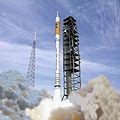English: The Ares I Crew Launch Vehicle is being developed at Marshall Space Flight Center in Huntsville, Alabama, and is a two-stage vehicle designed solely for carrying the Orion CEV to Earth orbit. The 94-meter-high, 5.5-meter-tall CLV will be launched from Kennedy Space Center's LC-39B pad (currently supporting Shuttle operations).
The first stage is a five-segment solid rocket booster providing 14,700 kN of thrust and derived from the Space Shuttle’s own SRBs (Solid Rocket Boosters). ATK will produce these and the identical boosters used on Ares V. The exhausted first stage will be recovered in the water, just like its predecessor, for testing and performance verification. The second stage is a fully-expendable cryogenic liquid booster to be built by Boeing and powered by a single J-2X engine derived from the second stage of the Saturn V moon rocket. This configuration is projected to deliver 25,000 kg to Low Earth Orbit.
The Orion CEV will sit on top of the second stage and be protected by a Launch Escape System during the initial stages of flight. The Launch Escape System consists of an aerodynamic protective cover that attaches over the Orion crew capsule and a tower equipped with solid-fueled escape motors and flight control hardware. To avoid a repeat of the Challenger incident, the crew is placed as far away from the actual rocket segments as possible. The Orion can be pulled away from the stack by the Launch Escape System's rocket motors in an emergency. The protective cover prevents damage to the crew capsule from debris and the exhaust of the escape motors.
Français : Le véhicule de lancement d'équipage Ares I est en cours de développement au centre de vol spatial de Marshall à Huntsville, Alabama, U.S.A. C’est un véhicule à deux étages conçu seulement pour mettre en orbite le CEV Orion. Ares I (94 mètres de haut, 5.5 mètres de large) sera lancé du pas de tir LC-39B du centre spatial Kennedy (d’où sont opérées actuellement les navettes spatiales U.S.).
Le premier étage est un propulseur à poudre de cinq segments fournissant le 14700 kN de poussée. Il est dérivé des SRBs de la navette spatiale (propulseurs à poudre). ATK produira ces derniers ainsi que les accélérateurs identiques utilisés sur Ares V. Le première étage sera récupéré, après tir, dans l'eau, juste comme son prédécesseur, pour des opérations de vérification de test et de performance. Le deuxième étage est un accélérateur à liquide cryogénique entièrement consommable construit par Boeing et propulsé par un dérivé du moteur J-2X utilisé lui-même dans le deuxième étage de la fusée lunaire Saturne V. Il est prévu que cette configuration mettra 25000 kilogrammes en orbite basse.
Le CEV Orion surmontera le deuxième étage et sera ‘protégé’ par un système d'évacuation au lancement pendant les phases initiales de vol. Le système d'évacuation au lancement se compose d'un protecteur aérodynamique couvrant les attaches au-dessus de la capsule d'équipage Orion, d’une tour équippée de propulseurs d'évacuation remplis de combustible solide et d’équipements de commande de vol. Pour éviter de réitérer l'incident de Challenger, l'équipage est placé aussi loin que possible des segments réels de la fusée. Orion peut être tiré loin de la fusée grâce aux propulseurs du système d'évacuation au lancement en cas d’urgence. Le carénage protecteur empêche l’endommagement de la capsule où se trouve l’équipage par les débris et les gaz d’échappement des propulseurs d'évacuation.



